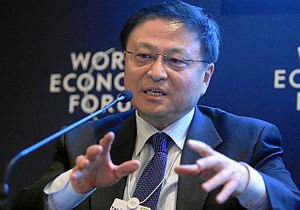The U.S.-China bilateral relationship is widely regarded by politicians, practitioners, and pundits as the world’s most important. Effectively managing China’s reemergence as a major power in the context of a U.S.-led international order is seen as key to continuing peace and security in the Asia-Pacific. But is working together the best way for China to get what it wants?
This was the subject of an op-ed published on 13 January in China’s Global Times by leading Chinese international relations scholar Yan Xuetong, Dean of the Institute of Modern International Relations at Tsinghua University in Beijing.
Yan’s article, entitled “Holistic ‘Periphery’ more important than the United States” (Chinese), argues that China’s rise will be more effectively achieved by fostering friendly ties with neighboring countries, rather than focusing on improving U.S.-China relations in order to reduce “American resistance.”
Yan asserts that the “inevitable course” of rising powers over world history has been to first become a regional power and then a global power. Thus, given China is not yet a global power and must avoid diplomatic overreach* “China must view its periphery as its most important diplomatic focus.”
Yan defines China’s “periphery” as East Asia, Russia, Central Asia, South Asia, and Southeast Asia, contending that “Faced with the reality that China is stronger than they are, neighboring countries must choose whether they support or obstruct China’s rise. This makes it possible for China to gain the support of [those] that wish to benefit from China’s rise,” weakening U.S. President Barack Obama’s “Pivot to Asia” strategy to reinforce American primacy in the region.
Yan’s op-ed is interesting because it encapsulates important tenets of Chinese President Xi Jinping’s emergent foreign policy. While Yan is not a policymaker, his strong realist views are often cited as close to the Chinese leadership, and an insider account suggests China’s political elite broadly share Yan’s “zero-sum game” assessment of inevitable competition for international influence between China as rising power in a new multipolar world order and the U.S. as resistant status-quo superpower.
But while under previous President Hu Jintao China assumed a muted international profile reflecting Deng Xiaoping’s dictum of “hiding one’s brilliance and biding one’s time“ (taoguang yanghui 韬光养晦), China is now also “striving for achievement“ (fenfa youwei 奋发有为) as a great power actively augmenting its global environment to achieve Xi’s signature campaign of “the great rejuvenation of the Chinese nation.”
Initially, Xi did focus on US-China ties, proposing at the June 2013 Sunnylands summit a “new type of great-power relations“ accentuating mutual respect for core interests. However, the perceived “suspicion and cynicism“ shown by the US towards Xi’s attempt to “elevate [China] to a level playing field” bolstered designs towards peripheral diplomacy.
At both the October 2013 Peripheral Diplomacy Work Conference and the November 2014 Central Conference on Work Relating to Foreign Affairs, Xi affirmed the importance for domestic growth of “common development with neighboring countries” to achieve a “more enabling international environment” for China’s rise. These followed regional diplomatic charm offensives selling the “win-win” prosperity and security of “peaceful development” with China.
Beijing-led proposals supporting this agenda include the Free Trade Area of the Asia-Pacific to envelop the U.S.-led Trans-Pacific Partnership, the $50 billion Asian Infrastructure Investment Bank to rival the Japan-led Asian Development Bank, and the $40 billion New Silk Road Economic Belt and 21st Century Maritime Silk Road – enormous networks of trade and investment projects connecting Europe, Africa, and Central, South, and Southeast Asia.
In particular, Yan identifies the New Silk Roads as key “infrastructure” to realise Xi’s vision to “turn China’s neighborhood areas into a community of common destiny,” aligning the economic, political, and security interests of periphery countries with China’s continued rise. The hope is that China can effectively buy accommodation of its security interests to counter the U.S. Pivot against them.
Yet the vast scale of China’s efforts reflects the magnitude of its task, as China is itself the greatest security concern of many periphery states. China’s uncompromising pursuit of its sovereignty claims amid multinational territorial disputes in the East and South China Seas, unyielding commitment to reunification with Taiwan, Indian border disputes, and rapid military modernization have encouraged virtually all East and Southeast Asian countries to support the Pivot as a hedge against possible Chinese domination and revisionism. Russia will also react to China edging it out of Central Asia.
Nevertheless, there are signs China’s peripheral diplomacy is making inroads: all South China Sea disputants joined the AIIB; many are on the New Silk Roads; strengthened ties with U.S.-friendly countries like South Korea, Thailand, and Myanmar; and even resumed dialogue with Japan.
Yan’s op-ed reflects current trends in Chinese foreign policy, but it remains to be seen whether China’s rise won’t be checked by the U.S., or its own belligerence.
Neil Thomas is a recent graduate of the University of Western Australia, Editor of the Journal of Australia-China Affairs, and Publications Director of the Australia-China Youth Association.
































